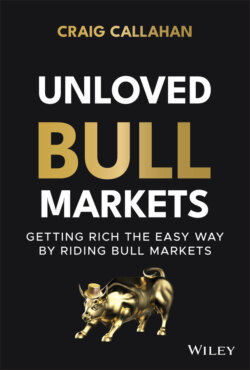Читать книгу Unloved Bull Markets - Craig Callahan - Страница 14
Investor Sentiment
ОглавлениеThe America Association of Individual Investors (AAII) conducts a weekly investment sentiment survey of its members. It asks, “Are you bullish, neutral, or bearish?,” meaning, does the respondent think the stock market is going higher, sideways, or lower? The survey began July 1987. Figure 1.2 shows a rolling four-week average of the percent bullish divided by the percent bearish from July 1987 through February 2020. The middle line is the average for the entire time period, right near 1.50%, meaning typically three bulls for every two bears. The other two lines are one standard deviation above and below average. Before focusing on the recent bull market, some general observations are noteworthy. This group can really be wrong sometimes. The two arrows above highlight some extremes like the excessive bullishness precrash 1987 and at the tech bubble peak of early 2000. Those were terrible times to be bullish. The four arrows at the bottom represent great buying opportunities when the market went higher but investors were extremely (incorrectly) bearish: 1990, 1998, 2003, and 2009.
Figure 1.2 AAII Bull/Bear Ratio, Four-Week Average
For the eleven-year bull market from 2009 through 2020, the bull/bear ratio is generally below average. There are a few quick bursts of optimism, when the bull/bear ratio got one standard deviation above the long-term average, but the optimism is nowhere near the magnitude or duration of those that occurred in previous bull markets. This group was mostly wrong the entire way up, frequently posting bull/bear ratios one standard deviation below the historic average.
Table 1.2 shows the average bull/bear reading during four bull markets based on the weeks when the bull market began and ended. Perhaps the bull market of December 1987 through February 1994 was “unloved” also because its average bull/bear ratio was similarly low as the recent bull market. In Chapter 2 we make the case that the sharp market drop in October 2008 was a “crash” and similar to the crash of October 1987. Perhaps severe sudden drops in the market affect investors’ sentiment for the subsequent bull market. Maybe crashes inflict some psychological damage. In any case, investors were much more bullish during the bull markets of the late 1990s and early 2000s. In summary, during this recent bull market, investors usually, and incorrectly, thought the market was going to go lower. We can only presume that they did not fully participate in the bountiful returns. That would seem to qualify as “unloved.”
As evidence that the bull market was “unloved” we saw investors pulling money from equity mutual funds unlike during previous bull markets. Investor sentiment explained that behavior because investors had a more negative view of the market than in the previous two bull markets. This doubt and skepticism were not limited to the individual investor. Some institutional investors, acting as fiduciaries and often presumed to be more sophisticated, demonstrated the same lack of love for equities.
Table 1.2 Average Weekly Bull/Bear Ratio (in %)
| 12/1987–2/1994 | 125.0 |
| 12/1994–3/2000 | 188.3 |
| 9/2002–10/2007 | 174.5 |
| 3/2009–2/2020 | 126.3 |
